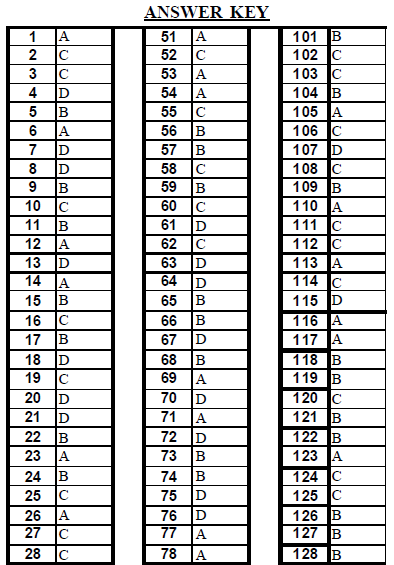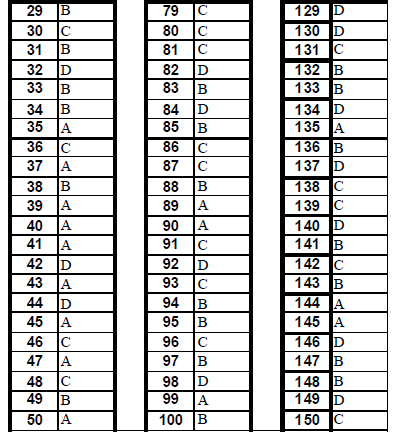IMPORTANT POINTS
The cell cycle is the series of events that takes place inside a cell thus leading to cell division and cell duplication. The cell cycle is divideds into two brief stages : (A) Interphase – during which the cell grows and accumulates nutrients needed for mitosis and DNA material duplicates in this stage It is further divided into G1, S and G2 (B) Mitosis (M) phase – during which the cell divides itself into two distinct cells, called “daughter cells”. Mitosis is also divided into four stages viz. prophase, metaphase, anaphase and telophase. During prophasecondensation of chromosomes takes place. Metaphase can be indicatd by arrangement of chromosomes at the equatorial plate. During anaphase centromeres divide and chromatids start moving towards the opposite poles. Each chromatid behaves like an individual chrosomosome during telophase. Nuclear membrane appeared and two nuclei are formed. Nuclear division (karyokinesis) is followed by cytoplasmic division and is called cytokinesis.
There are two stages of meiosis, namely, meiosis I and meiosis-II. Meiosis – I iscalled reduction division or heterotypic division while meiosis – II is called homotypic division. The parent cell or the dividing cell undergoes a preparatory phase, known as interphase, before entering the two stages of meiosis. Meiosis – I and II consist four common phases viz. prophase, metaphase, anaphase and telophase. The prophase of meiosis – I is a long phase which is further divide into five phases. These are leptotene, zygotene, pachytene,diplotene, and dikenesis. Due to formation of bivalent spindle the chromosomes which are arranged at the equatorial plate during metaphase are pulled towards the opposite poles during anaphase. Each pole receives half the chromosome number of the parental cell during telophase. At the completion of telophase, nuclear membrane and nucleolus reappear. Meiosis – II is similar to mitosis. Both the daughter cells formed by meiosis – I undergo meiosis – II and produce four haploid daughter cells.
The stage between two meiotic stages in called interkinesis and is generally short lived.
1. Approximately how many cells are present in the body of an adult person ?
(a) 1014 (b) 1015 (c) 1018 (d) 1021
2. The period between two successive cell divisions in called ___
(a)Duplication (b) Growth phase (c) Cell cycle (d) Interphase
3. Which is fundamental property of all living organisms ?
(a)Respiration (b) Germination (c) Growth (d) Photosynthesis
4. Which factors are required for growth ?
(a) An increase in group of cells, a duplication of genetic material
(b) An increase in group of cells, production of daughter cells by mitosis
(c) A dupliction of genetic material and a division assuring that daughter cells receive an equal complement of genetic material.
(d) An increase in cell mass, a duplication of genetic material, a division assuring that each daughter cell receives an equal complement of the genetic material
5. With how many cell reproduction starts ?
(a)Two cells (b) Single cell (c) Many cells (d) Somatic cell
6. Which of the following is present in maximum number in an adult person ?
(a)Somatic cell (b) Gamete (c) Reproductive cell (d) Zygote
7. At the end of which stage does cell enter mitosis ?
(a)G1 - phase (b) S - phase (c) M - phase (d) G2 - phase
8. What is synthesized during G2 – phase ?
(a)Protein (b) Micro tubules (c) RNA (d) (a) and (b)
9. The sequence in the cell cycle is _____
(a) S, G1, G2 M (b) G1, S G2, M (c) S, M G1, G2, M (d) G2, S, M, G1
10. Synthesis of RNA and protein takes place in which phase of the cell cycle ?
(a)S-phase (b) M-phase (c) G1-phase (d) Metaphase
11. During which phase can nucleolus be observed clearly ?
(a)Metaphase-II (b) Early Prophase
(c)Anaphase (d) Metaphase
12. Which structure can be observed at the surface of centromere during metaphase ?
(a)Kinetochores (b) Chromatophore (c) Kinetophore (d) Chromatophore
13. Mitosis actually means _____
(a)Reduction in number of chromosomes
(b)Division of nucleus only
(c)Division of cytoplasm only
(d)Both nuclear (Karyokinesis) and cytoplasmic divisions.
14. The role of mitosis is not merely to divide a cell into two daugher cells but to ensure genetic continuity from one cell generation. The mechanism ensuring genetic continutity is;
(a)Formation of two cells with identical DNA
(b)The new cells have half the number of chromosomes.
(c)Formation of cell by new chromosome
(d)Formation of two daughter cells
15. Substances that interface with microtubule function interfare with cell division because ____
(a)Microtubules are distributed equally in the new cells
(b)Microtubules are involved in precise separate set of chromosomes get into each daughter cells.
(c)Without microtubules, cytokinesis cannot take place and a membrane is formed.
(d)Microtubules are essential for the disappearince of the nuclear membrane and without them the chromosomes have to stay close together within the nuclear membrave to be able to separate into two new nuclei.
16. The stage of mitosis during which the nucleolus disintegrates and chromosomes appear is known as
(a) Interphase (b) Metaphase (c) Prophase (d) Anaphase
17. Chromosomes can be counted during :
(a)Prophase (b) Metaphase (c) Anaphase(d) Telophase
18. The nuclear membrane disintegrates and spindle appears at :
(a)Prometaphase (b) Early prophase
(c)Late telophase (d) Late prophase
19. The separation of two chomatids of each chromosome during early anaphase is initiated by :
(a)The interaction of centromere with the chromosomal fibres.
(b)The elongation of metaphytic spindle
(c)Attachment of spindle fibres with Kinetochore
(d)All the above
20. The telophase stage of mitosis is ____
(a)The last stage of karyokinesis
(b)More or less opposite of prophase stage.
(c)The stage where spindle fibres are abosorbed in cytoplasm
(d)All of the above
21. The term ‘karyokinesis’ is used for ___
(a) Disappearance of nuclear mimbrane during metaphase
(b) Changes occuring at anaphase, when chromosomes move to the opposite poles.
(c) Event occuring during interphase
(d) Over all changes occurring in nucleus during the cell division.
22. How many mitotic divisions must occur in a cell to form 1024 cells ?
(a) 20 (b) 10 (c) 40 (d) 64
23. The difference in the division of a plant cell and animal cell is in ____
(a) Cell membrane formation
(b) Spindle formation
(c) Movement of chromosomes from equatorial plane
(d) Coiling of the chromosomes
24. During which phase of prophase-I of meiosis does the process of synapsis occur ?
(a)Pachytene (b) Zygotene
(c)Leptotene (d) Diplotene
25. In mitosis the daughter cells resemble to their parent cell. But in meiosis they differ not only from parent cell in having half the number of chromosomes, but also differ among themselves qualitatively in genetic constitution due to____
(a)Segragation and crossing over only
(b)Independent assortment and segregation only
(c)Crossing over, independent assortment and segregation
(d)Independent assortment and crossing over only
26. Which is the longest phase of meitoic division ?
(a)Prophase-I (b) Metaphase-I (c) Anaphase-I (d) Telophase-I
27. At which stage, the homologous chromosomes separate due to repulsion, but are yet held by chiasmata :
(a)Zygotene (b) Pachytene (c) Diplotene (d) Diakinesis
28. If there are four chromosomes present during prophase – I, how many chromosome are there in each cell at the end of anaphase - II
(a) 4 (b) 8 (c) 2 (d) 16
29. Meiosis – II is :
(a)Cell division (b) Mitotic division
(c)Commonly cell elongation (d) Reduction division
30. Significance of meiosis is associated with :
(a)DNA duplication (b) Asexual reproduction
(c)Sexual reproduction (d) Growth of the body
31. The minimum number of meiotic divisions required to obtain 100 pollen grain of wheat is ____
(a) 40 (b) 25 (c) 150 (d) 200
32. The number of meiotic divisions required to produce 400 seeds in a pea plant is _____
(a) 200 (b) 700 (c) 500 (d) 400
33. Significance of meiosis ____
(a)The number of chromosomes is maintained in all cells.
(b)It is important process for evolution
(c)Due to division, cell can maintain their efficient size.
(d)A very significant contributing of mitosis is cell repair
34. In which of the following matters mitosis and meiosis are similar ?
(a)Both are precede by DNA replication
(b)Both have pairing of homologous chromosomes
(c)Both process occurs in all kinds of cells
(d)Both include separation of paired chromosomes.
35. During which of the following phases of mitosis asters appear around the centroles ?
(a)Prophase (b) Metaphase
(c)Anaphase (d) Telophase
36. During which stage of meiosis crossing over takes place ?
(a)Leptotene (b) Zygotene (c) Dikinesis (d) Pachytene
37. At which of the following stage4s of cell cycle proteins and microtubules, required for mitosis, are synthesized ?
(a)G2 phase (b) G1 phase (c) Interphase (d) M phase
38. If the initial amout of DNA is denoted as 2C then it increases into :
(a) 2C (b) 4C (c) 8C (d) 6C
39. A. During interphase, chromosomes are recognized as chromatin network.
R. Chromosomes are highly dispersed during this phase.
(a)Both A and R are true and R is correct explanation of A.
(b)Both A and R are true and R is not correct explanation of A
(c)A is true and R is wrong
(d)I is wrong and R is true
40. A. G1 phase is also called growth phase.
R. There is a lot of biosynthetic activity during
(a)Both A and R are true and R is correct explanation of A.
(b)Both A and R are true and R is not correct explanation of A
(c)A is true and R is wrong
(d)A is wrong and R is true
41. A. The meiotic division-I is also called reduction division.
R. During this the chromosomes are distributed in two cells in half their number.
(a)Both A and R are true and R is correct explanation of A.
(b)Both A and R are true and R is not correct explanation of A
(c)A is true and R is wrong
(d)A is wrong and R is true
42. A. During meiosis, the genetic material is replicated twice whereas the cell divides one.
R. Meiosis takes place in plants and animals during the formation of reproductive cells.
(a)Both A and R are true and R is correct explanation of A.
(b)Both A and R are true and R is not correct explanation of A
(c)A is true and R is wrong
(d)A is wrong and R is true
43. A. Number of chiasmata is more in longer chromosomes.
R. The number of chiasmata depends on the length of chromosomes.
(a)Both A and R are true and R is correct explanation of A.
(b)Both A and R are true and R is not correct explanation of A
(c)A is true and R is wrong
(d)A is wrong and R is true
44. Statement – P : G1 stage is the last stage or interphase.
Statement – Q : Systhesis of DNA takes place in G2 stage.
(a)Statement P and Q both are correct
(b)Statement P is correct statement Q is wrong
(c)Statement P is wrong and statement Q is correct
(d)Statement P and Q both are wrong
45. Statement – P : Interphase is divided in three sub phases.
Statement – Q : G1 phase is the initial phase of interphase.
(a)Statement P and Q both are correct
(b)Statement P is correct statement Q is wrong
(c)Statement P is wrong and statement Q is correct
(d)Statement P and Q both are wrong
46. Statement – P : In ‘S’ stage centrosome is duplicated
Statement – Q : In the prophase centrioles separate from each other and move towards the opposite poles.
(a)Statement P and Q both are correct
(b)Statement P is correct statement Q is wrong
(c)Statement P is wrong and statement Q is correct
(d)Statement P and Q both are wrong
47. For the statement ‘X’ and statement ‘Y’ which of the following option is correct ?
Statement – ‘X’ :During meiosis the genetic material is replicated once.
Statement – ‘Y’ : Genetic material is not replicated during interkinesis.
(a)Both statements ‘X’ and ‘Y’ are correct
(b)‘X’ is correct and ‘Y’ is wrong
(c)Both statements ‘X’ and ‘Y’ are wrong
(d)‘X’ is wrong and ‘Y’ is correct
48. Match the following :
Coulmn-I Coulmn-II
(A) G1 Phase (i) Synthesis of proteins and Microtubules
(B) S Phase (ii) Growth phase
(C) G2 Phase (iii) Replication of DNA
(a) (A - i) (B - ii) (C - iii)
(b)(A - iii) (B - ii) (C - i)
(c) (A - ii) (B - iii) (C - i)
(d)(A - i) (B - iii) (C - ii)
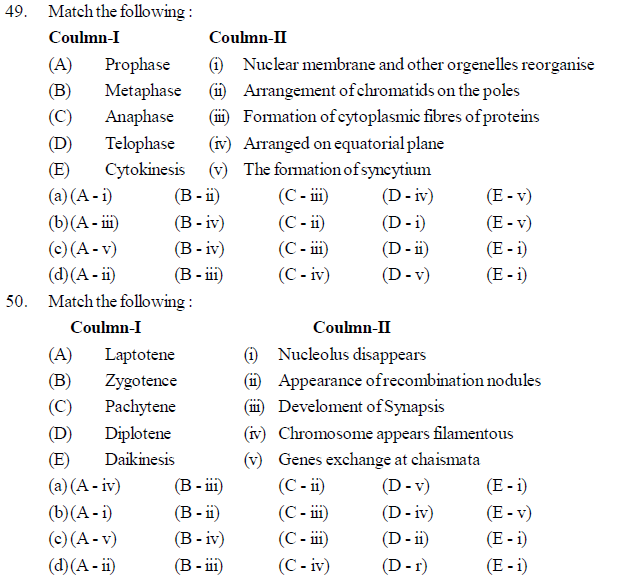
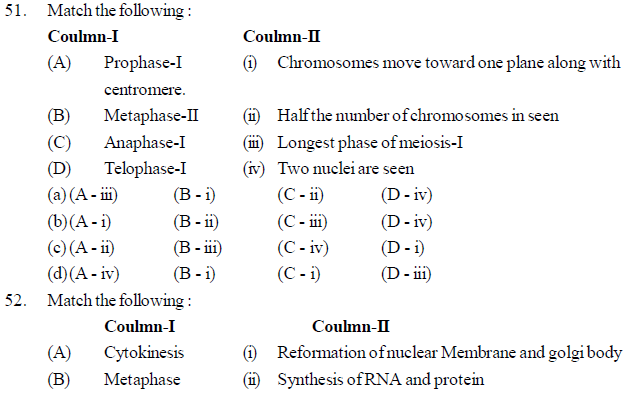

53. Select correct statement’s for cell cycle.
(i) Yeast cell can complete on cell cycle in every 90 minutes
(ii) A period between creation of a cell and division of that cell.
(iii) Cell cycle is mainly divided into interphase and differentiation like two phases.
(a) (i) and (ii) only (b) (i) and (iii) only
(c) (ii) and (iii) only (d) (i), (ii) and (iii)
54. Which of the following statement is/are correct for prophase of mitosis ?
(i) At the end of this phase nuclear membrane and nucleolus disintegrate.
(ii) At the end of this phase two chromosome and a centromere holding them together.
(iii) This phase begins with the condensation of chromatids along their lengths.
(a) (i) only (b) only (i) and (ii)
(c) only (ii) and (iii) (d) (i) and (iii)
55. Which of the following statement is/are correct for Prophase-I ?
(i) During diplotene, the members of each pair of homologous chromosomes start moving away from one another.
(ii) In zygotene, bivalent chromosomes appear tetravalent.
(iii) In diakinesis, chromatids become separated even at the site of chiasmata.
(a) only (i) (b) only (ii)
(c) only (i) and (iii) (d) (i), (ii) and (iii)
56. Which of the following statement is/are correct for Meiosis-II ?
(i) Chromosomes are arranged on equatorial plate in prophase-II
(ii) Nucleolus disappear during telophase-II
(iii) In anaphase-II, the chromatids with their independent centromeres are called chromosomes.
(iv) In metaphase-II, centromere of each chromosome becomes attached to filament of bipolar spindle.
(a) only (i) and (ii) (b) only (iii) and (iv)
(c) only (i), (ii) and (iii) (d) (i), (ii) and (iii)
57. Find out the incorrect pair.
(a)Telophase – Chromatin is observed
(b)G1 phase – New DNA is synthesized
(c)Prophase – nuclear membrane disintegrates
(d)Zygotene - Synapsis
58. Find the incorrect pair.
(a)Bipolar spindle – Cytoplasmic fibres of protein
(b)Prophase – Chromosome made up of two chromatids and centromere
(c)Anaphase – Equatorial plate
(d)Metaphase - Kinetochore
59. From the following which pair does not match ?
(a)S – state – Synthesis of DNA
(b)Meiosis – One parental cell produces two daughter cells
(c)Anaphase – Each chomatid with independent centromere.
(d)Zygotene - Synapsis
60. Which one is a correct pair ?
(a)G2 phase – Growth phase (c) S phase – DNA synthesis
(b)M phase - Interphase (d) G1 phase – RNA and DNA synthesis
61. “The number of chiasmata depends on chromosomes” – What is the mistake in the given statement ?
(a)Width of chromosome – Word in not mentioned
(b)Size of chromosome – Word is not mentioned
(c)Number of chromosome – Word is not mentioned
(d)Length of chromosome – Word is not mentioned
62. Which is the true statement for mitosis ?
(a)Cell formed by it performs diverse functions i.e. show division of labour
(b)The number of chromosomes in the new cells are half than that of the parent cell.
(c)Two cells are formed as a result of this division are identical in all aspects.
(d)Cells formed as a result of mitosis have different genetic characters.
63. Which of the following statement is true for mitosis ?
(a)Cytokinesis and karyokinesis occur together
(b)Cytokinesis and karyokinesis are random
(c)Cytokinesis preceedes karyokinesis
(d)Karyokinesis preceedes cytokinesis
64. During interphase ____
(a)Replication of DNA occurs. (c) Replication of centriole.
(b)Chromosomes can be observed only as chromatin. (d) All the above.
65. Indentify the correct sequence of karyokinesis stages :
(a)Prophase, Anaphase, Metaphase, Telophase
(b)Prophase, Metaphase, Anaphase, Telophase
(c)Prophase, Telophase, Metaphase, Anaphase
(d)Prophase, Metaphase, Telophase, Anaphase
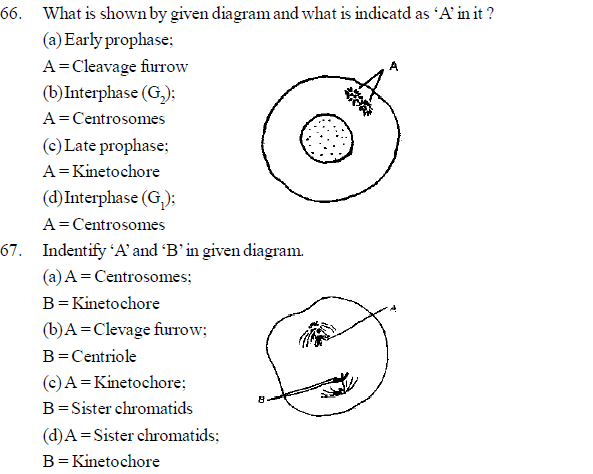
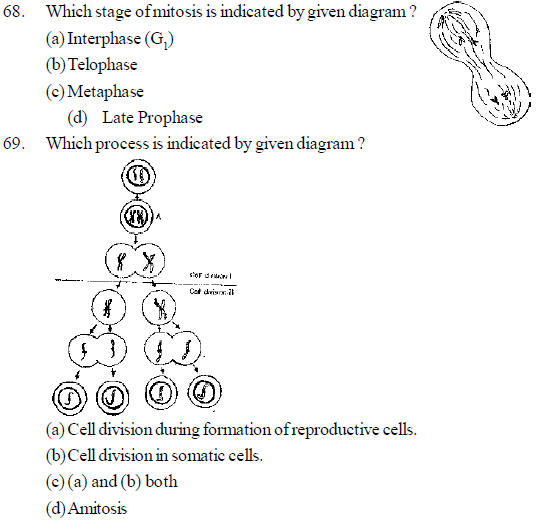
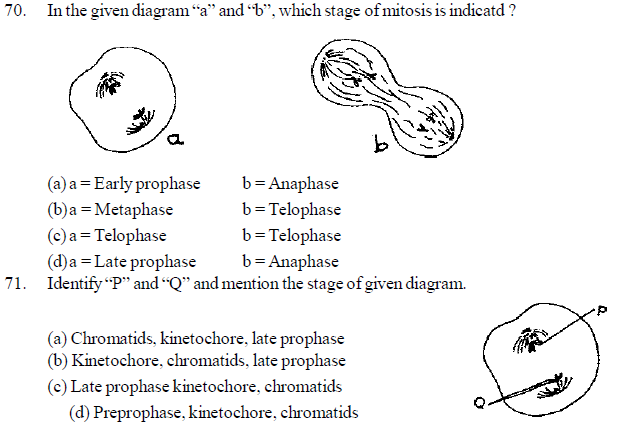
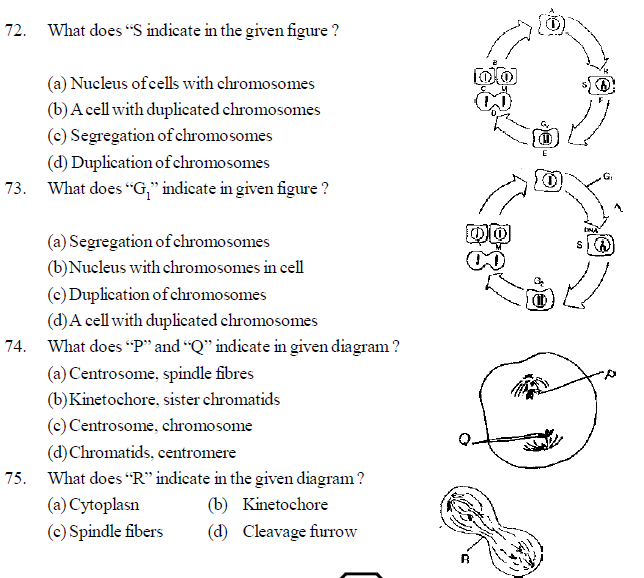
76. Which of the following cell can complete one cell cycle in 90 minutes ?
(a)Plant cell (b) Animal Cell (c) Angal cell(d) Yeast Cell
77. Which plant material is best suited for studying mitosis in class room ?
(a)Root tips (b) Anther (c) Pieces of bark (d) Shoot apex
78. Mitosis can occur in
(a)Haploid and diploid cells both (b) Pollen mother cells
(c)Haploid cell only (d) Diploid cell only
79. Genetic homogeneity and exact similarity between chromosomes of various cell within the same type of issue of plant is due to :
(a)Cytokinesis (b) Meiosis (c) Mitosis (d) Fertilization
80. Spindle fibres are composed of :
(a)Lipids (b) Pectins (c) Proteins (d) Cellulose
81. In the plant cell, cytokinesis occurs by
(a)Separation of the cytoplasm from the periphery to central region.
(b)Separation of the cytoplasm throughout the equatorial plane simultaneously
(c)Separation of the cytoplasm from cell centre to its periphery
(d)Following of cytoplasm from two side at right angles to the plane of spindle pole
82. Cytokinesis is generally, but not always, seen in mitosis. If cells undergo mitosis and do not follow cytokinesis then it would result in :
(a)Cells with abnormal small nuclei (b) Ensuring genetic homogeneity of cell
(c)A cell with a single large nucleus (d) A cell with two or more nuclei
83. How many time is the genetic material replicated during meiosis ?
(a) Twice (b) Once (c) Four times (d) None of the above
84. How does the pairs of homologous chromosomes appear during zygotene phase ?
(a)Univalent (b) Trivalent (c) Tetravalent (d) Bivalent
85. In which of the following stages chromosomes are not seen clearly ?
(a)Leptotene (b) Prophase-II (c) Diplotene (d) Metaphase-III
86. During prophase – I of meiosis homologous chromosomes pair with each other to form bivalent.
A bivalent is an association of :
(a) Two chromatids and two centromeres (c) Four chromatids and two centromeres
(b) Four chromatids and four centromeres (d) Two chromatids and one centromere
87. Crossing over involves ___
(a)Duplication of chromosomes (b) Deletion of chromosomes
(c)Exchange of genetic matetial (d) Addition of chromosome
88. Crossing over occurs between _____
(a)Non – homologous chromatids of non homologous chromosomes
(b)Non – sister chromatids of homologous chromosomes
(c)Sister chromatids of homologous chromosomes
(d)Sister chromatids of non homologous chromosome
89. During meiosis centromere divides :
(a)Only one at anaphase - II (b) Only once at anaphase – I
(c)Twice in meiosis – I & II (d) Twice in each cell at the end of anaphase – I & II
90. Which of the following occurs only during meiosis ?
(a)Pairing of homologous chromosomes (b) Separation of duplicated stands
(c)Cytokinesis (d) Disappearance of nucleolus
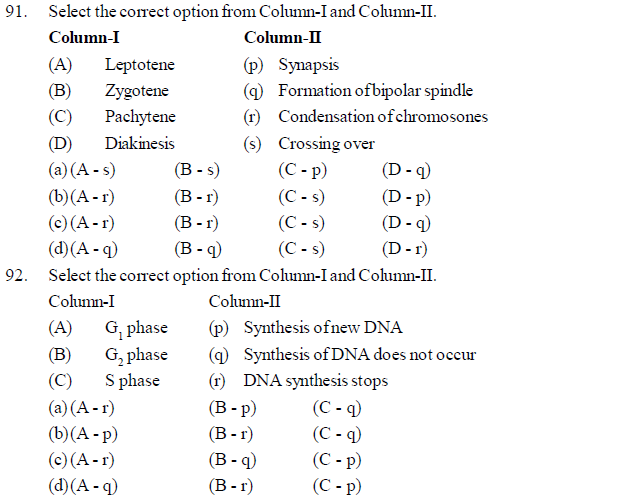
93. Due to crossing over, an opportunity for the exchange of genes becomes possible.
(a)S - phase (b) Cell Cycle (c) Significance of meiosis (d) G2 phase
94. Which of the following statement is true for prophase ?
(a)At the end of this phase chromosomes disappear.
(b)In this phase condensation of chromosome takes place along their lengths.
(c)At the end of this phase nuclear membrane is formed
(d)Centriole divides and arranged on opposite pole.
95. Syncytium means ____
(a) small disc shaped structures at the surface of the centromeres.
(b)a condition arises when karyokinesis is not followed by cytokinesis.
(c) process of constriction of cytoplasm from peripheral region of cell that extends towards the centre.
(d)a multinucleate condition arises when karyokinesis and cytokinesis is over.
96. In animal cell _____
(a) constriction of cytoplasm begins from the peripheral region of the cell.
(b)middle lamella made up of pectin develops.
(c) constriction of cytoplasm begins from the centre of the cell.
(d)(a) and (b) both
97. Given below is a schematic break-up of the phases/stage of cell cycle :
(a)C Karyokinesis
(b)D Synthetic phase
(c)A Cytokinesis Metaphase
(d)B Metaphase
98. Spindle fibre shorten.
(a)Prophase (b) Telophase (c) Metaphase (d) Anaphase
99. Nucleus is reformed
(a)Telophase-I (b) Prophase-II (c) Anaphase-II (d) Metaphase-II
100. Pair of homologous chromosomes become arranged at the equatorial plane of the cell.
(a) Metaphase-II (b) Metaphae-I (c) Metaphase (d) Zygotene
101. The period between two successive divisions is called _____
(a) Cell division (b) Cellcycle (c) Interphase (d) G1 phase
102. The chromosomes are distributed in two cells in half thir number is called.
(a) Mitosis (b) Cytokineis (c) Heterotypic division (d) Cellcycle
103. What is the average cell cycle span of a human cell ?
(a) 17 Hrs. (b) 20 Hrs. (c) 24 Hrs. (d) 30 Hrs.
104. During cell cycle DNA replication takes place in _______
(a) G1 - phase (b) S - phase (c) G2 - phase (d) M - phase
105. During which of the following phase of mitosis asters appear round the centrioles ?
(a)Prophase (b) Metaphase (c) Anaphase (d) Telophase
106. At Which sub stage of meiosis crossing over takes place ?
(a) Leptotene (b) Zygotene (c) Pachytene (d) Diplotene
107. During which of the following stage of division nuclear membrane and nucleolus reappear ?
(a) Prophase (b) Metaphase (c) Anaphase (d) Telophase
108. What is average cell cycle span of a Yeast cell ?
(a) 70 min. (b) 85 min. (c) 90 min. (d) 120 min.
109. Interphase can be divided into how many sub phases ?
(a) 2 (b) 3 (c) 8 (d) 5
110. In how many phase the mitosis can be divided ?
(a) 4 (b) 8 (c) 3 (d) 5
111. The result of meiosis is the formation of ____
(a) 4 cells (b) 2 cells (c) 8 cells (d) 6 cells
112. The locations at which crossing over occurs are known as ____
(a)Centromere (b) Kinetochore (c) Chiasmata (d) Centriole
113. Complete disintegration of nuclear membrane and nucleolus take place during which stage of mitosis ?
(a)Prophase (b) Metaphase (c) Anaphase (d) Telophase
114. Which of the following structure will not be common to mitotic cell of a higher plant ?
(a) Cell plate (b) Centromere (c) Centriole (d) Spindle fibre
115. How many mitotic division are needed for a single cell to make 128 cells ?
(a) 54 (b) 25 (c) 34 (d) 7
116. Series of cell division is :
(a) prophase, metaphase, anaphase, telophase
(b)prophase, anaphase, metaphase, telophase
(c) prophase, metaphase, telophase, anaphase
(d)anaphase, metaphase, telophase, prophase
117. Meiosis involves :
(a) two nuclear division and one chromosome division
(b)two each nuclear and chromosome division
(c) one each nuclear and chromosome division
(d)one nuclear and two chromosomes division
118. The sequence of cell cycle is :
(a) S, M, G1 and G2 (b) G1, S, G2 and M
(c) G1, G2, S and M (d) M, G1, G2 and S
119. Which of the correct order of phases in prophsae I ?
(a)Leptotene, diakinesis, pachytene, diplotene, zygotene
(b)Leptotene, zygotene, pachytene, diplotene, diakinesis
(c)Diakinesis, diplotene, pachytene, zygotene, leptotene
(d)Laptotene, pachytene, zygotene, diplotene, dikinesis
120. In how many cells the meiotic division has taken place, if the total number of gametes produced are 32 ?
(a) 4 (b) 16 (c) 8 (d) 32
121. Prophase is characterized by :
(a) spliting of centromere
(b) thread like appearance of chromosomes
(c) arrangement of chromosomes on metaphic plate
(d)pairing of homologous chromosome
122. Given :
(1)Chromatid (2) Monad
(3)Dyad (4) Daughter Chromosomes
(a) 1, 2, 3, 4 (b) 2, 3, 1, 4 (c) 3, 2, 1, 4 (d) 4, 3, 2, 1
123. Phase of cell cycle unique for DNA replication is :
(a)S (b) G1
(c)G2 (d) M
124. Pairing of homologous chromosomes during zygotene is termed :
(a) synapse (b) synapsida
(c) synapsis (d) crossing over
125. At which stage of mitosis chromatids separate and passes to different poles :
(a)Prophase (b) Metaphase
(c)Anaphase (d) Telophase
126. G2 phase is between :
(a) end of mitosis and start of S phase
(b)end of S phase and start of mitosis
(c) start of S phase and start of mitosis
(d)end of S phase and end of mitosis
127. Post mitotic gap phase and synthesis phase of cell cycle are also respectively referred to as :
(a)G2 and S (b) G1 and S (c) G1 and G2 (d) S and G2
128. The two chromatids of a metaphase chromosome represents :
(a) homologous chromosome of a diploid set
(b)replicated chromosomes to be separated at anaphase
(c) non-homologous joined at the centromere
(d)maternal and paternal chromosomes joined at the centromere
129. If you are provided with root-tips of onion in your class and are asked to count the chromosome, which of the following stage can you most conviently look into
(a)Telophase (b) Anaphase (c) Prophase (d) Metaphase
130. What is correct ?
(a)DNA – content become double during G1 phase.
(b)Duration of interphase is short as compared to M – phase.
(c)G2 – phase follows mitotic phase.
(d)DNA – replication occurs in S – phase.
131. A cell divides every one minute. At this rate of division it can fill a 100 ml of beaker in one hour.
How much time does it take to fill a 50 ml beaker ?
(a) 30 minute (b) 60 minute (c) 59 minute (d) 32 minute
132. At which phase of meiosis, the 2 cell, each with separated sister chromatids move towards opposite poles :
(a) anaphase-I (b) anaphase-II (c) metaphase-I (d) metaphase-II
133. During meiosis crossing over occurs between which part of homologous chromosome ?
(a) sister chromatids (b) nonsister chromatids
(c) genes (d) alleles
134. During mitotic metaphase :
(a) crossing over occurs
(b)chromosomes are divided
(c) chromosomes become thread like and condensed
(d) chromosomes are located at equator.
135. In meiosis the daughter cells are not similar to that of parent because of :
(a) crossing over (b) Synapsis (c) both (a) and (b) (d) none of these
136. When synapsis is completed all along the chromosome, the cell is said to have entered a stage called :
(a) zygotene (b) pachytene (c) diplotene (d) diakinesis
137. Pick out the correct statements :
(A) Synapsis of homologous chromosomes takes place during prophase-I of meiosis.
(B) Division of centromeres takes place during anaphase I of meiosis.
(C) Spindle fibres disappear completely in telophase of mitosis.
(D) Nucleoli reappear at telophase I of meiosis
(a)A only (b) C only (c) A and B only (d) A, C, and D only
138. Assertion (A) : Phase of cell division is also known as dividing phase.
Reason (R) : In mitotic phase new cells are produced from pre-existing cells through meiosis division.
(a) Both A and R are true and R is the correct explanation of A.
(b) Both A and R are true but the R is not the correct explanation of A.
(c) A is true statement but R is false.
(d) Both A and R are false.
139. Synapsis occurs between :
(a) m-RNA and ribosomes (b) spindle fibres and centromere
(c) two homologous chromosomes (d) a male and a female gamete
140. During mitosis nuclear membrane and nucleolus begin to disappear at :
(a) Early mataphase (b) Late metaphase
(c) Early prophase (d) Late prophase
141. Cell cycle is divided in stages as given below Which is the correct pair ?
(a) C – kietochore (b) D – synthesis phase
(c) A – cytokinesis (d) B – metaphase
142. IN which stage of mitosis division segregation of chromatids occur and they migrate at different polar ends.
(a)Prophase (b) Metaphase (c) Anaphase(d) Telophase
143. Number of chromosomes are maintained from generation to generation by :
(a) Mitotic division (b) Meiosis division (c) Division (d) Metamorphosis
144. How many meiotic stage are essential for producing 28 cells from one cell ?
(a) 7 (b) 14 (c) 28 (d) 64
145. In diploid living organisms crossing over is responsible for ?
(a) Recombination of linked genes (b) Dominancy of genes
(c) Linkage between genes (d) No Segregation of genes
146. What would be the number of chromosomes of the aleurone cells of a plant with 42 chromosomes in its root tip cells ?
(a) 84 (b) 21 (c) 42 (d) 63
147. Select the correct option with respect to mitosis.
(a) Golgi complex and endoplasmic reticulum are still visible at the end of prophase.
(b) Chromosomes move to the spindle equator and get aligned along equatorial plate inmetaphase.
(c) Chromatids separate but remain in the centre of the cell in anaphase.
(d) Chromatids start moving towards opposite poles in telophase.
148. During gamete formation, the enzyme recombinase participate during :
(a) Anaphase-II (b) Prophase-I (c) Prophase-II (d) Mataphase-I
149. Given below is the representation of a certain event at a particular stage of a type of cell division. Which is this stage ?
(a)Prophase-II during meiosis (b) Prophase of mitosis
(c)Both prophase and metaphae of mitosis(d) Prophase-I during meiosis
150. The time period between meiotic I and meiotic II cell division is called :
(a) interphase (c) interkinesis
(b)growth phase (d) 1st gap
